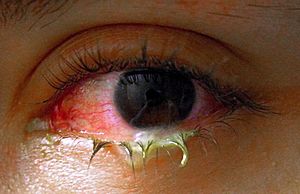Pus facts for kids

Pus is a thick, often yellowish liquid that your body makes when it's fighting an infection or inflammation. It's a sign that your immune system is working hard to get rid of harmful germs, like bacteria. Pus is mostly made up of dead white blood cells, dead germs, and damaged tissue.
What is Pus?
Pus is a fluid that forms when your body's defense system is battling an infection. It can be white, yellow, green, or even brown. The color often depends on the type of germs causing the infection. Pus usually feels thick and can sometimes have a bad smell.
How Does Your Body Make Pus?
When germs enter your body, your immune system sends out special cells to fight them. These cells are a type of white blood cell called neutrophils and macrophages.
- Neutrophils are like tiny soldiers that attack and destroy the germs.
- Macrophages are like cleanup crews that eat up the dead germs and cell debris.
During this fight, many of these white blood cells die. When they die, along with dead germs and damaged body tissue, they collect together to form pus. It's like the "battlefield cleanup" after your body wins a fight against invaders.
What Causes Pus?
Pus usually forms because of a bacterial infection. Common examples include:
- Pimples and boils: These are small pockets of pus under the skin.
- Infected cuts or wounds: If a cut gets germs in it, pus can form.
- Abscesses: These are collections of pus that can form anywhere in the body.
- Ear infections or sore throats: Sometimes, pus can be seen in these areas.
Less often, pus can be caused by other conditions that are not infections, such as certain skin problems.
Why is Pus Important?
Even though pus might look a bit gross, it's actually a good sign! It means your body is actively fighting off an infection. When pus forms, it helps to trap the germs in one place. This stops them from spreading to other parts of your body. Once the infection is under control, the pus will usually drain out or be absorbed by your body.
See also
 In Spanish: Pus para niños
In Spanish: Pus para niños

